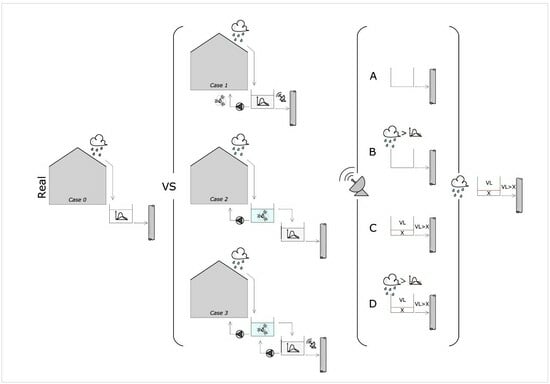Multi-Objective Performance of Detention Basins and Rainwater Harvesting Systems Using Real-Time Controls with Rainfall Forecasts
Abstract
:1. Introduction
2. Materials and Methods
2.1. Case Study Area
2.2. Inputs
2.2.1. Precipitation
- Total precipitation: 22,790 mm;
- Average annual rainfall: 760 mm/year;
- Number of days with precipitation greater than 1 mm: 2340 days/30 years, about 80 days/year.
2.2.2. Subcatchments and Rainwater Harvesting System
2.2.3. Water Demand for Non-Potable Use
2.3. System Configurations
- Ac: subcatchment corresponding to the total drained area (about 1.369 hectares);
- VR: RWH tank with different maximum volumes (named X);
- VL: water volume in the detention basin (maximum value = 700 m3; maximum height = 2 m);
- Pwd: pump dedicated to satisfying the water demand for non-potable purposes to be used for toilet flushing, corresponding to 10.13 m3/d and operating on workdays (from Monday to Friday);
- P1: discharge pump connected to the rainfall forecast system and to the receiving water body;
- P2: discharge pump during rain events connected to the receiving water body;
- P3: replenishing pump, from the detention basin to the RWH storage, is activated when the volume VR is lower than its predetermined maximum while VL is greater than 0;
- TpR: overflow threshold located 2 m from the bottom of the RWH tank toward the detention basin;
- TpL: overflow threshold located 2 m from the bottom of the detention basin spilling toward the receiving water body.
- Case 0: the real case with a pump that is activated if there is a volume greater than 0 in the tank;
- Case 1: the detention basin is equipped with an emptying system both in case of precipitation and if rain is expected; this scenario is implemented with a rainwater harvesting system, and the non-potable water is reused for toilet flushing;
- Case 2: the subcatchment is connected to a rainwater harvesting system that discharges the excess water into the detention basin that, as in case 0, is equipped with a drain pump and an overflow weir;
- Case 3: like case 2, the subcatchment is connected to a rainwater harvesting system, and any excess of water, with respect to the capacity of the tank, is delivered into the detention basin; the detention basin provides a control on the output so as to guarantee accumulation on dry days to restore the water inside the RWH tank; at the same time, it empties in case of rain and in a preventive way, thanks to a control system based on weather forecasts.
- Type A: P1 status is on for 18 h to guarantee emptying of the tank when rain is expected; P2 status is on during the rainfall event if the volume VL is greater than a predetermined volume X; if P2 is active, then P1 goes off;
- Type B: P1 status is on when rain is expected which generates a flow rate greater than 10.95 L/s, which is the maximum discharge flow rate; P2 status is on during the rainfall event if the volume VL is greater than a predetermined volume X; if P2 is active, then P1 goes off;
- Type C: P1 status is on when rain is expected and the volume VL is greater than a predetermined volume X; P2 status is on during the rainfall event if the volume VL is greater than a predetermined volume X; if P2 is active, then P1 goes off;
- Type D: P1 status is on when rain is expected, which generates a flow rate greater than 10.95 L/s, and the volume VL is greater than a predetermined volume X; P2 status is on during the rainfall event if the volume VL is greater than a predetermined volume X; if P2 is active, then P1 goes off.
2.4. Performance Assessment
- Case 0 was developed to simulate unmanaged discharge (real configuration) as a point of reference to compare the performance of the other scenarios;
- Case 1 was modeled to evaluate the efficiency of the detention basin used at the same time as an RWH tank, managing the discharge using a rainfall forecasting system or during the event if the volume in the tank exceeds a determinate level. This case makes it possible to evaluate the reduction in the outflow volume as the storage capacity dedicated to the RWH system varies and according to the type of control on the discharge;
- Case 2 was modeled to compare, for the same volume, the level of efficiency given by a RWH system compared to cases 1 and 3;
- Case 3 was modeled to improve the detention basin with a RWH system, with a replenishing pump that connects the detention basin to the RWH tank to reintegrate the water.
- Average efficiency of the system: ;
- Reduction in the total volume discharged in 30 years: ;
- Increase in peak flow discharged in 30 years: .
3. Results and Discussion
- Efficiency: defined by Equation (2);
- Discharge: the volume sent to the downstream system during the events;
- Overflow: the volume sent to the downstream system through an overflow weir;
- Pre-storm release: the volume sent to the downstream system before the rainfall event;
- Volume reduction: defined by Equation (3);
- Total overflow peak: the sum of the flow peaks discharged by the overflow weir;
- Peak flow increase: defined by Equation (4).
4. Conclusions
Author Contributions
Funding
Data Availability Statement
Conflicts of Interest
References
- Haase, D. Effects of urbanisation on the water balance—A long-term trajectory. Environ. Impact Assess. Rev. 2009, 29, 211–219. [Google Scholar] [CrossRef]
- Barron, O.V.; Barr, A.D.; Donn, M.J. Effect of urbanisation on the water balance of a catchment with shallow groundwater. J. Hydrol. 2013, 485, 162–176. [Google Scholar] [CrossRef]
- Garofalo, G.; Giordano, A.; Piro, P.; Spezzano, G.; Vinci, A. A distributed real-time approach for mitigating CSO and flooding in urban drainage systems. J. Netw. Comput. Appl. 2017, 78, 30–42. [Google Scholar] [CrossRef]
- Burns, M.J.; Fletcher, T.D.; Walsh, C.J.; Ladson, A.R.; Hatt, B.E. Hydrologic shortcomings of conventional urban stormwater management and opportunities for reform. Landsc. Urban Plan. 2012, 105, 230–240. [Google Scholar] [CrossRef]
- Zipper, S.C.; Motew, M.; Booth, E.G.; Chen, X.; Qiu, J.; Kucharik, C.J.; Carpenter, S.R.; Loheide II, S.P. Continuous separation of land use and climate effects on the past and future water balance. J. Hydrol. 2018, 565, 106–122. [Google Scholar] [CrossRef]
- Cipolla, S.S.; Altobelli, M.; Maglionico, M. Systems for rainwater harvesting and greywater reuse at the building scale: A modelling approach. Environ. Eng. Manag. J. 2018, 17, 2349–2360. [Google Scholar] [CrossRef]
- Basinger, M.; Montalto, F.; Lall, U. A rainwater harvesting system reliability model based on nonparametric stochastic rainfall generator. J. Hydrol. 2010, 392, 105–118. [Google Scholar] [CrossRef]
- Xu, W.; Fletcher, T.; Duncan, H.; Bergmann, D.; Breman, J.; Burns, M. Improving the Multi-Objective Performance of Rainwater Harvesting Systems Using Real-Time Control Technology. Water 2018, 10, 147. [Google Scholar] [CrossRef]
- Gee, K.D.; Hunt, W.F. Enhancing Stormwater Management Benefits of Rainwater Harvesting via Innovative Technologies. J. Environ. Eng. 2016, 142, 04016039. [Google Scholar] [CrossRef]
- Campisano, A.; Butler, D.; Ward, S.; Burns, M.J.; Friedler, E.; De Busk, K.; Fisher-Jeffes, L.N.; Ghisi, E.; Rahman, A.; Furumai, H.; et al. Urban rainwater harvesting systems: Research, implementation and future perspectives. Water Res. 2017, 115, 195–209. [Google Scholar] [CrossRef]
- Di Matteo, M.; Liang, R.; Maier, H.R.; Thyer, M.A.; Simpson, A.R.; Dandy, G.C.; Ernst, B. Controlling rainwater storage as a system: An opportunity to reduce urban flood peaks for rare, long duration storms. Environ. Model. Softw. 2019, 111, 34–41. [Google Scholar] [CrossRef]
- Gaborit, E.; Muschalla, D.; Vallet, B.; Vanrolleghem, P.A.; Anctil, F. Improving the performance of stormwater detention basins by real-time control using rainfall forecasts. Urban Water J. 2013, 10, 230–246. [Google Scholar] [CrossRef]
- Silva, F.; Calheiros, C.S.C.; Albuquerque, A.; Lopes, J.P.; Antão-Geraldes, A.M. Technical and Financial Feasibility Analysis of Rainwater Harvesting Using Conventional or Green Roofs in an Industrial Building. Sustainability 2023, 15, 12430. [Google Scholar] [CrossRef]
- Shetty, N.; Wang, M.; Elliott, R.; Culligan, P. Examining How a Smart Rainwater Harvesting System Connected to a Green Roof Can Improve Urban Stormwater Management. Water 2022, 14, 2216. [Google Scholar] [CrossRef]
- Bus, A.; Szelągowska, A. Green Water from Green Roofs—The Ecological and Economic Effects. Sustainability 2021, 13, 2403. [Google Scholar] [CrossRef]
- Silva, F.; Calheiros, C.S.C.; Valle, G.; Pinto, P.; Albuquerque, A.; Antão-Geraldes, A.M. Influence of Green Roofs on the Design of a Public Stormwater Drainage System: A Case Study. Sustainability 2023, 15, 5762. [Google Scholar] [CrossRef]
- Lefkowitz, J.R.; Sarmanian, A.K.; Quigley, M. Continuous monitoring and adaptive control—The internet of things transforms stormwater management. J. New Engl. Water Environ. Assoc. 2016, 50, 44–51. [Google Scholar]
- Roman, D.; Braga, A.; Shetty, N.; Culligan, P. Design and Modeling of an Adaptively Controlled Rainwater Harvesting System. Water 2017, 9, 974. [Google Scholar] [CrossRef]
- Braga, A.; O’Grady, H.; Dabak, T.; Lane, C. Performance of Two Advanced Rainwater Harvesting Systems in Washington DC. Water 2018, 10, 667. [Google Scholar] [CrossRef]
- Marchese, D.; Johnson, J.; Akers, N.; Huffman, M.; Hlas, V. Quantitative Comparison of Active and Passive Stormwater Infrastructure: Case Study in Beckley, West Virginia. Proc. Water Environ. Fed. 2018, 2018, 4298–4311. [Google Scholar] [CrossRef]
- Liang, R.; Di Matteo, M.; Maier, H.; Thyer, M. Real-Time, Smart Rainwater Storage Systems: Potential Solution to Mitigate Urban Flooding. Water 2019, 11, 2428. [Google Scholar] [CrossRef]
- Abawallo, S.S.; Brandimarte, L.; Maglionico, M. Analysis of the performance response of offline detention basins to inlet structure design: Performance response of offline detention basin design. Irrig. Drain. 2013, 62, 449–457. [Google Scholar] [CrossRef]
- Gambi, G.; Maglionico, M.; Tondelli, S. Water management in local development plans: The case of the old Fruit and Vegetable Market in Bologna. Procedia Eng. 2011, 21, 1110–1117. [Google Scholar] [CrossRef]
- Campisano, A.; Modica, C. PID and PLC units for the real-time control of sewer systems. Water Sci. Technol. 2002, 45, 95–104. [Google Scholar] [CrossRef] [PubMed]
- Campisano, A.; Creaco, E.; Modica, C. Application of Real-Time Control Techniques to Reduce Water Volume Discharges from Quality-Oriented CSO Devices. J. Environ. Eng. 2016, 142, 04015049. [Google Scholar] [CrossRef]
- Casadio, A.; Cipolla, S.S.; Maglionico, M.; Martinini, P. Numerical modeling of the sewer system of Rimini (Italy) and strategies for the CSOs reduction on the Adriatic Sea. Environ. Eng. Manag. J. 2013, 12, 121–124. [Google Scholar]
- Zanni, S.; Cipolla, S.S.; Di Fusco, E.; Lenci, A.; Altobelli, M.; Currado, A.; Maglionico, M.; Bonoli, A. Modeling for sustainability: Life cycle assessment application to evaluate environmental performance of water recycling solutions at the dwelling level. Sustain. Prod. Consum. 2019, 17, 47–61. [Google Scholar] [CrossRef]
- Martins Vaz, I.C.; Istchuk, R.N.; Oneda, T.M.S.; Ghisi, E. Sustainable Rainwater Management and Life Cycle Assessment: Challenges and Perspectives. Sustainability 2023, 15, 12133. [Google Scholar] [CrossRef]



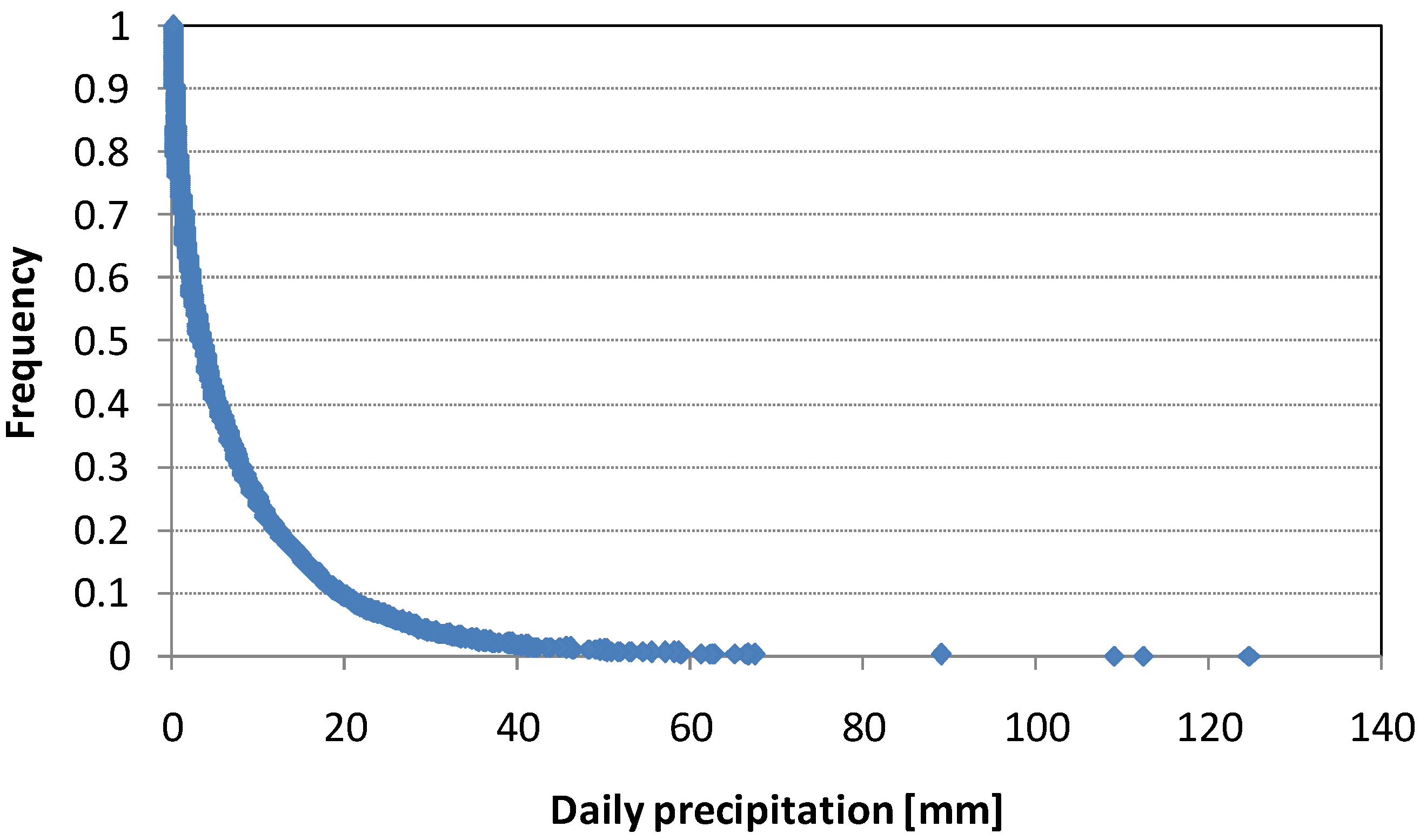



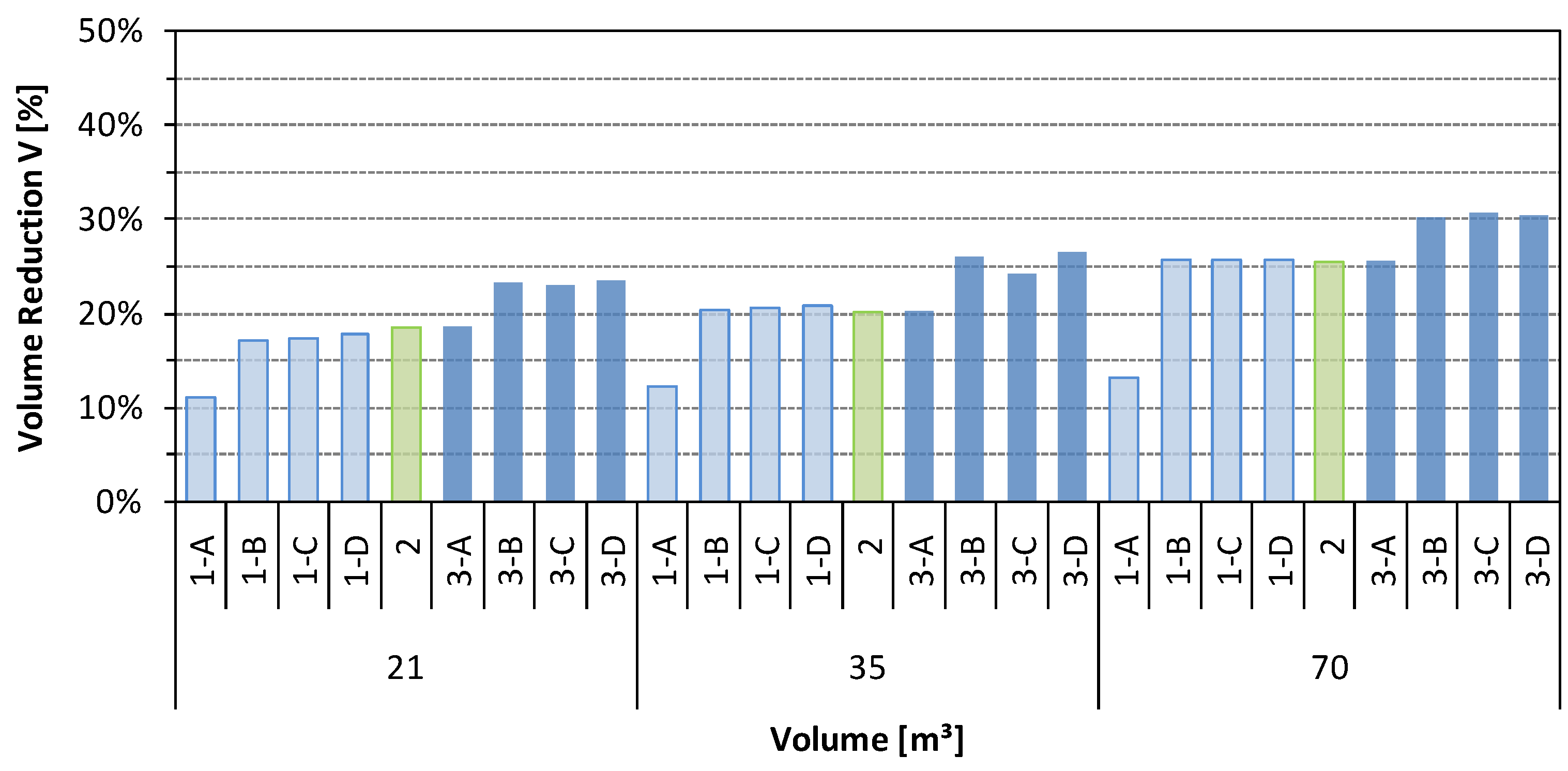

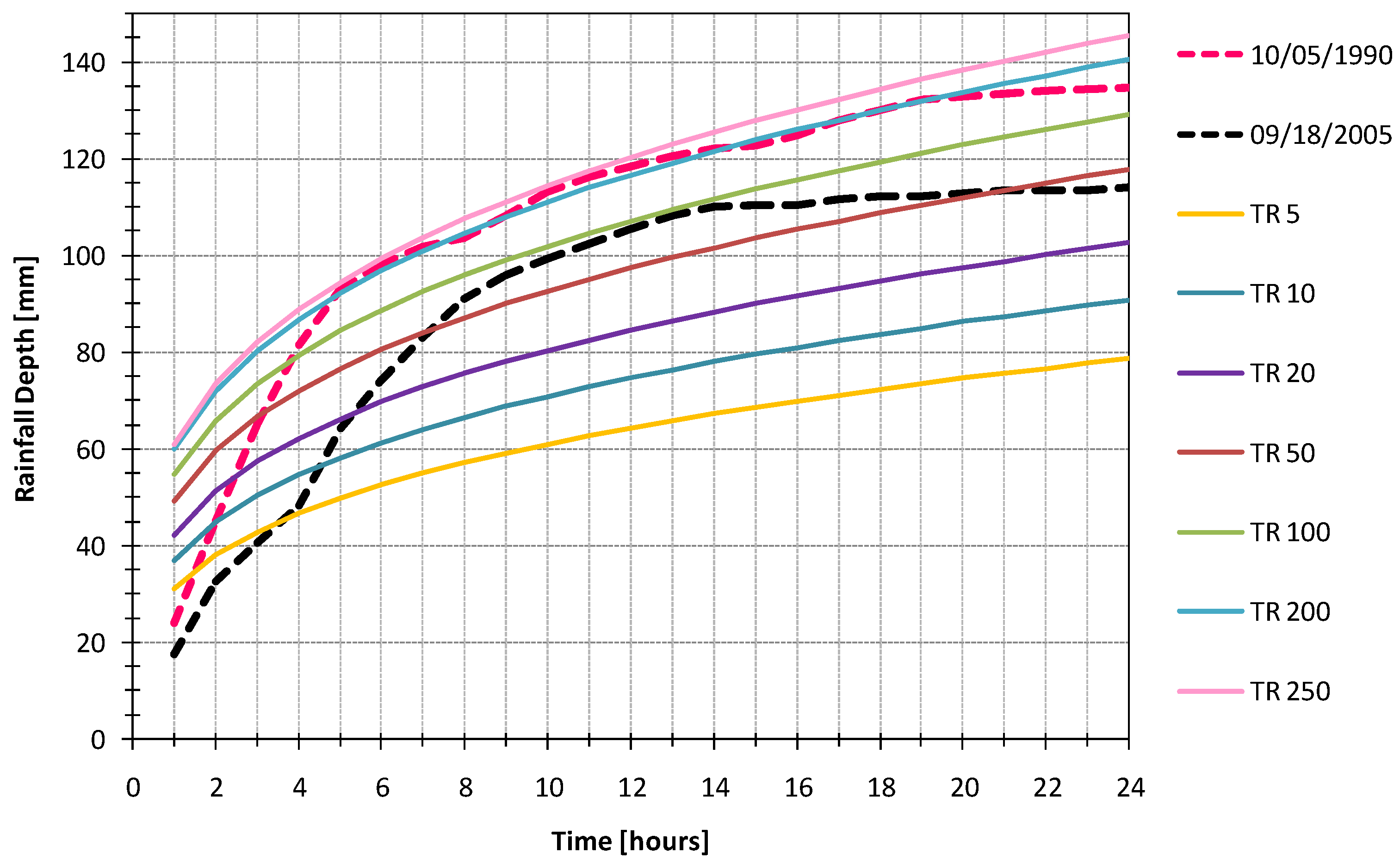
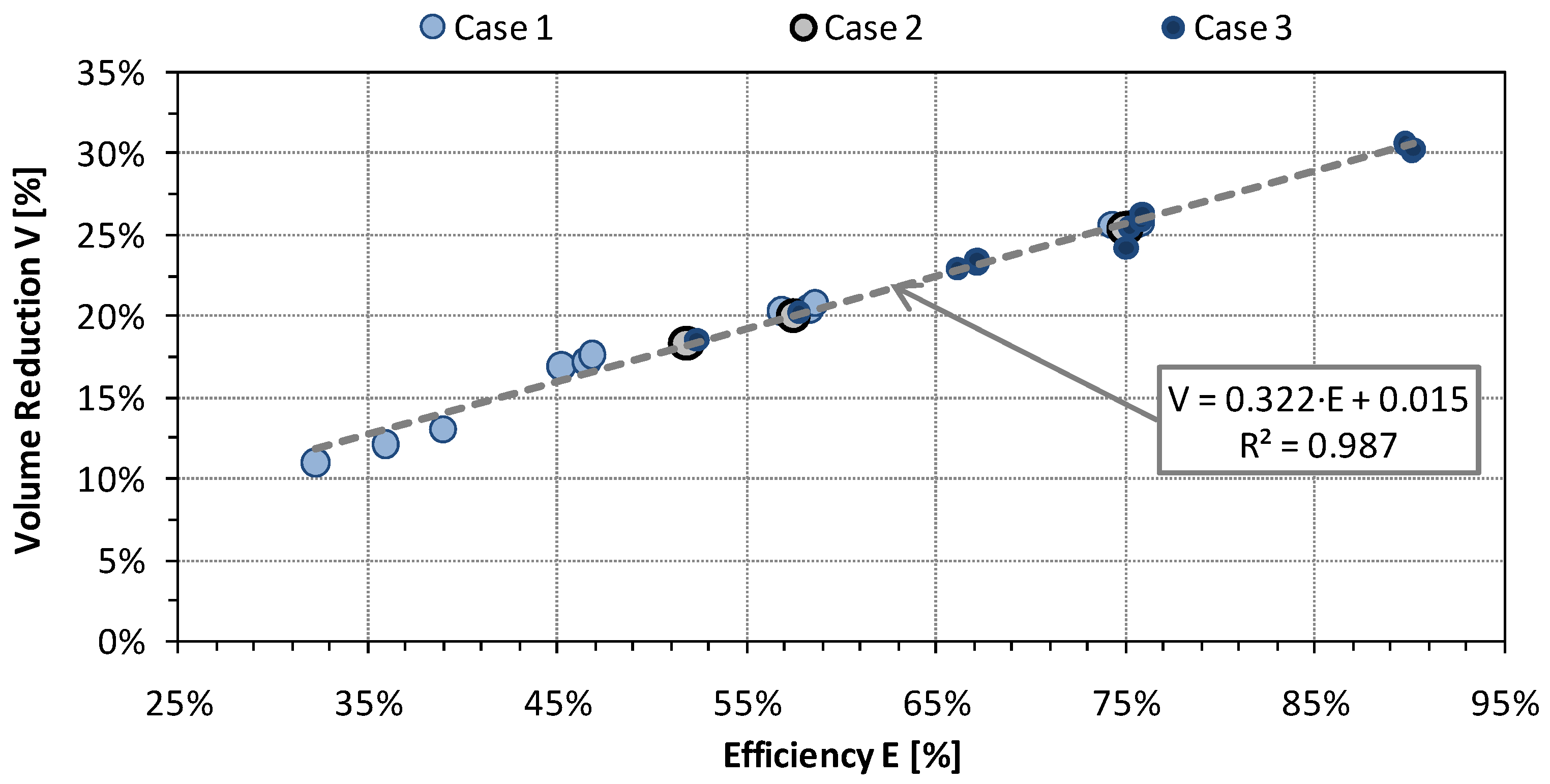
| Cases | Efficiency E [%] | Discharge | Overflow | Pre-Storm Release | Total Discharge | Volume Reduction V [%] | Total Overflow Peak [L/s] | Peak Flow Increase I [% ] |
|---|---|---|---|---|---|---|---|---|
| 0 | N/A | 261,589 | 305 | N/A | 261,894 | - | 94.7 | - |
| 1-A-21 | 32.2 | 72,602 | 302 | 160,300 | 233,204 | 11.0 | 94.5 | −0.2 |
| 1-A-35 | 35.9 | 55,040 | 302 | 174,842 | 230,184 | 12.1 | 94.5 | −0.2 |
| 1-A-70 | 39.0 | 33,330 | 302 | 194,148 | 227,780 | 13.0 | 94.5 | −0.2 |
| 1-B-21 | 45.2 | 208,128 | 325 | 9031 | 217,484 | 17.0 | 105.0 | 15.9 |
| 1-B-35 | 56.9 | 195,257 | 340 | 13,094 | 208,691 | 20.3 | 106.1 | 17.7 |
| 1-B-70 | 74.3 | 172,413 | 440 | 22,009 | 194,862 | 25.6 | 108.7 | 24.0 |
| 1-C-21 | 46.5 | 172,039 | 325 | 44,476 | 216,840 | 17.2 | 105.0 | 15.9 |
| 1-C-35 | 58.3 | 164,785 | 340 | 43,175 | 208,300 | 20.5 | 106.1 | 17.7 |
| 1-C-70 | 75.5 | 154,379 | 440 | 39,883 | 194,702 | 25.7 | 108.7 | 24.0 |
| 1-D-21 | 46.9 | 214,139 | 325 | 1153 | 215,617 | 17.7 | 105.0 | 15.9 |
| 1-D-35 | 58.6 | 206,029 | 340 | 1094 | 207,463 | 20.8 | 106.1 | 17.7 |
| 1-D-70 | 75.8 | 193,030 | 440 | 1074 | 194,544 | 25.7 | 108.7 | 24.0 |
| 2-21 | 51.8 | 213,248 | 301 | N/A | 213,549 | 18.5 | 93.8 | −0.9 |
| 2-35 | 57.3 | 208,819 | 301 | N/A | 209,120 | 20.2 | 93.7 | −0.9 |
| 2-70 | 75.0 | 194,751 | 301 | N/A | 195,052 | 25.5 | 93.6 | −1.0 |
| 3-A-21 | 52.3 | 59,435 | 303 | 153,523 | 213,261 | 18.6 | 94.5 | −0.2 |
| 3-A-35 | 57.7 | 45,146 | 303 | 163,446 | 208,895 | 20.2 | 94.5 | −0.2 |
| 3-A-70 | 75.1 | 26,264 | 303 | 168,431 | 194,998 | 25.5 | 94.4 | −0.3 |
| 3-B-21 | 67.1 | 191,690 | 325 | 8863 | 200,878 | 23.3 | 104.9 | 15.8 |
| 3-B-35 | 75.8 | 181,943 | 340 | 11,752 | 194,036 | 25.9 | 106.1 | 17.7 |
| 3-B-70 | 90.1 | 161,750 | 439 | 20,570 | 182,759 | 30.2 | 108.6 | 23.9 |
| 3-C-21 | 66.0 | 152,723 | 325 | 48,674 | 201,722 | 23.0 | 104.9 | 15.8 |
| 3-C-35 | 75.0 | 149,500 | 340 | 48,595 | 198,436 | 24.2 | 106.1 | 17.7 |
| 3-C-70 | 89.7 | 137,536 | 439 | 43,628 | 181,603 | 30.7 | 108.6 | 23.9 |
| 3-D-21 | 67.1 | 198,923 | 325 | 1114 | 200,362 | 23.5 | 104.9 | 15.8 |
| 3-D-35 | 75.8 | 191,463 | 340 | 1025 | 192,828 | 26.4 | 106.1 | 17.7 |
| Cases | Efficiency Min. [%] | Efficiency Max. [%] | Volume Reduction Min. [%] | Volume Reduction Max. [%] |
|---|---|---|---|---|
| Case 1 | 32 | 76 | 11 | 26 |
| Case 2 | 52 | 75 | 18 | 26 |
| Case3 | 58 | 90 | 20 | 31 |
| Types | Efficiency Min. [%] | Efficiency Max. [%] | Volume Reduction Min. [%] | Volume Reduction Max. [%] |
|---|---|---|---|---|
| A | 32 | 75 | 11 | 26 |
| B | 45 | 90 | 17 | 30 |
| C | 47 | 90 | 18 | 31 |
| D | 47 | 90 | 18 | 30 |
Disclaimer/Publisher’s Note: The statements, opinions and data contained in all publications are solely those of the individual author(s) and contributor(s) and not of MDPI and/or the editor(s). MDPI and/or the editor(s) disclaim responsibility for any injury to people or property resulting from any ideas, methods, instructions or products referred to in the content. |
© 2023 by the authors. Licensee MDPI, Basel, Switzerland. This article is an open access article distributed under the terms and conditions of the Creative Commons Attribution (CC BY) license (https://creativecommons.org/licenses/by/4.0/).
Share and Cite
Altobelli, M.; Evangelisti, M.; Maglionico, M. Multi-Objective Performance of Detention Basins and Rainwater Harvesting Systems Using Real-Time Controls with Rainfall Forecasts. Water 2024, 16, 71. https://doi.org/10.3390/w16010071
Altobelli M, Evangelisti M, Maglionico M. Multi-Objective Performance of Detention Basins and Rainwater Harvesting Systems Using Real-Time Controls with Rainfall Forecasts. Water. 2024; 16(1):71. https://doi.org/10.3390/w16010071
Chicago/Turabian StyleAltobelli, Margherita, Margherita Evangelisti, and Marco Maglionico. 2024. "Multi-Objective Performance of Detention Basins and Rainwater Harvesting Systems Using Real-Time Controls with Rainfall Forecasts" Water 16, no. 1: 71. https://doi.org/10.3390/w16010071






